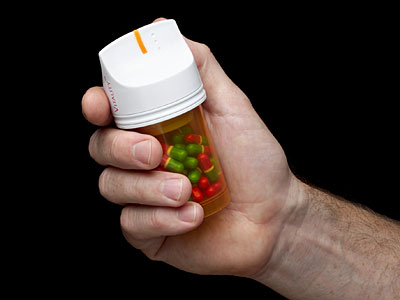Nine Technologies that Will Change Your Future
For 88 years, subscribers have relied on The Kiplinger Letter for insights into emerging technologies that will change the way Americans live and do business.

For 88 years, subscribers have relied on The Kiplinger Letter for insights into emerging technologies that will change the way Americans live and do business. Examples of "you read it first in Kiplinger" include the rise of commercial air routes in 1927, the early development of television in the 1930s, electronic office machines in 1953 and mobile phones in 1983.
What will be the tech breakthroughs of the next decade? Here are nine we're following. The slideshow begins with the navigation at right.

Biometrics on the Move
Banks are increasingly turning to biometric authentication for mobile and online clients. Fingerprint, voice and face recognition systems will soon become commonplace as banks seek to heighten security for the rising tide of on-the-go transactions.
Customers are accepting such security measures more readily these days. Many smart phones are already outfitted with cameras and only need a face recognition application; in a few, fingerprint scanners are embedded as well. They’re already in some laptops, and Microsoft’s Windows 7 operating system contains the needed recognition software. Citibank intends to test the waters first in Australia with voice recognition. Look for the trend to spread quickly to other banks as well as to other countries.

Self-Driving and Folding Cars
GM’s prototype EN-V (Electric Networked Vehicle) is just a third of the length and weight of today’s average car, thanks to an all-electric, rechargeable power system. There’s no bulky engine, transmission or braking system, plus it has built-in smarts to navigate on its own and avoid hitting other vehicles.
The all-electric CityCar (seen here), developed by the Massachusetts Institute of Technology, can squeeze its eight-foot length into a more compact five feet, allowing it to fit in teeny urban parking spots.

Personal Bar Codes
A digital code on your business card could soon let folks you meet scan contact information directly into smart phones or other mobile devices on the spot, ensuring correct spelling and phone numbers.
There are plenty of marketing uses for bar codes as well: On property listings -- to allow prospective buyers to download info. Postings at restaurants let patrons peek at menus and specials or tip off friends to their whereabouts. For retailers of all stripes, bar codes provide a chance to interact with consumers, making a digital connection.

Genetically Modified Critters
Uncle Sam’s OK is expected soon for the first genetically modified food animal -- no, not this pig -- but for farm-raised salmon with a gene from a wild chinook salmon. The gene-jiggered fish is engineered to grow at twice the pace of its unaltered farm raised progenitors.
Next up: Meet “Enviropig,” a porker genetically altered to make the manure it produces less polluting, with phosphorus levels 30%-65% lower than normal. Also in the works: Cattle that are not susceptible to mad cow disease. The animals lack the protein that mutates, so they don’t get the disease and can’t pass it on.

Farm-raised Pharma
A better understanding of genetics is also leading to changes in other sectors. In agriculture, scientists can tweak genes to make disease resistant animals. Plus they’re using genetically altered animals -- cattle, for one -- to make antibodies to fight diseases such as botulism and anthrax.
Eventually, the isolated antibodies may be approved for injection into humans to protect against those diseases. Researchers are also using genetically altered swine to grow pancreatic tissue that can be implanted in human diabetics to restore their ability to produce insulin.

New Cancer Treatments
Genetic advances go way beyond a few drugs. Consider Oncotype DX, a test developed by Genomic Health. It can identify whether breast cancer in a specific patient is aggressive and likely to recur. That gives doctors and patients more information when considering whether chemotherapy is a good move.
Similar tests may do the same for colon, renal and prostate cancers. Dako, the global diagnostic company, is developing a test to select patients with metastatic stomach cancer who may benefit from Herceptin, a breast cancer drug. If the test shows chemotherapy won’t help, doctors and patients can decide against it, avoiding unnecessary pain, and saving $15,000-$20,000 in medical costs. That scenario could be replicated for scores of other treatments.

New Drug Therapies
Genetic testing is revolutionizing medicine, offering doctors and patients more-educated choices. Using personal gene info, doctors can match patients with the therapies most likely to prove successful.
The Food & Drug Administration is on the cusp of approving a promising drug for lupus, Benlysta, from Human Genome Sciences and GlaxoSmithKline. Gene mapping will also make drug development faster and cheaper. All this could mean big savings in health costs as well as better results.

Power up on the Roof
On the horizon: A novel solar roofing system with appeal for homeowners. Dow Chemical will soon roll out shingles with embedded solar cells. Other companies, such as Lumeta, SRS Energy and SunPower, offer similar power generating shingles and tiles, but Dow’s have a difference: They can be installed by any roofing contractor. An electrician is needed only for the final plug-in. Others require wiring each shingle.
Solar roofing systems offer big advantages over more conventional solar panels: In addition to being less bulky and more attractive, they offer more flexibility and can cover entire roofs, including irregular spaces, to capture more power.

Time For Your Pill
Half of all Americans don’t get prescriptions filled or take prescription medicines when they should. Such negligence contributes to higher costs as people get sicker instead of better. Pharmacy benefit managers can help. Medco Health Solutions, for example, has pharmacists reach out to patients who don’t seem to be heeding doctors’ orders.
One tech solution: A pill bottle cap that lights up when it’s time for a dose. The GlowCap, made by Vitality Inc., emits a pulsing orange light, followed by a beep that becomes increasingly insistent until the bottle is opened. No response will prompt an electronic phone call or e-mail.

More from Kiplinger
Body Scanners Taking to the Streets
Best of Everything 2010: Tech Gadgets and Deals
8 Robots that Will Change Your Life
Get Kiplinger Today newsletter — free
Profit and prosper with the best of Kiplinger's advice on investing, taxes, retirement, personal finance and much more. Delivered daily. Enter your email in the box and click Sign Me Up.
-
 Stock Market Today: Stocks Gain on Tech, Auto Tariff Talk
Stock Market Today: Stocks Gain on Tech, Auto Tariff TalkThe Trump administration said late Friday that it will temporarily halt tariffs on some Chinese tech imports.
By Karee Venema Published
-
 Sam's Club Plans Aggressive Expansion: Discover Its New Locations
Sam's Club Plans Aggressive Expansion: Discover Its New LocationsSam's Club expansion plans will open up to 15 new stores each year. Learn where they plan to open in 2025.
By Sean Jackson Published
-
 What to Do With Your Tax Refund: 6 Ways to Bring Growth
What to Do With Your Tax Refund: 6 Ways to Bring GrowthUse your 2024 tax refund to boost short-term or long-term financial goals by putting it in one of these six places.
By Rachael Green Published
-
 What Does Medicare Not Cover? Eight Things You Should Know
What Does Medicare Not Cover? Eight Things You Should KnowHealthy Living on a Budget Medicare Part A and Part B leave gaps in your healthcare coverage. But Medicare Advantage has problems, too.
By Donna LeValley Published
-
 15 Reasons You'll Regret an RV in Retirement
15 Reasons You'll Regret an RV in RetirementMaking Your Money Last Here's why you might regret an RV in retirement. RV-savvy retirees talk about the downsides of spending retirement in a motorhome, travel trailer, fifth wheel or other recreational vehicle.
By Bob Niedt Published
-
 The Six Best Places to Retire in New England
The Six Best Places to Retire in New Englandplaces to live Thinking about a move to New England for retirement? Here are the best places to land for quality of life, affordability and other criteria.
By Stacy Rapacon Last updated
-
 The 10 Cheapest Countries to Visit
The 10 Cheapest Countries to VisitWe find the 10 cheapest countries to visit around the world. Forget inflation woes, and set your sights on your next vacation.
By Quincy Williamson Last updated
-
 15 Ways to Prepare Your Home for Winter
15 Ways to Prepare Your Home for Winterhome There are many ways to prepare your home for winter, which will help keep you safe and warm and save on housing and utility costs.
By Donna LeValley Last updated
-
 Six Steps to Get Lower Car Insurance Rates
Six Steps to Get Lower Car Insurance Ratesinsurance Shopping around for auto insurance may not be your idea of fun, but comparing prices for a new policy every few years — or even more often — can pay off big.
By Donna LeValley Published
-
 How to Increase Credit Scores — Fast
How to Increase Credit Scores — FastHow to increase credit scores quickly, starting with paying down your credit card debt.
By Lisa Gerstner Last updated
